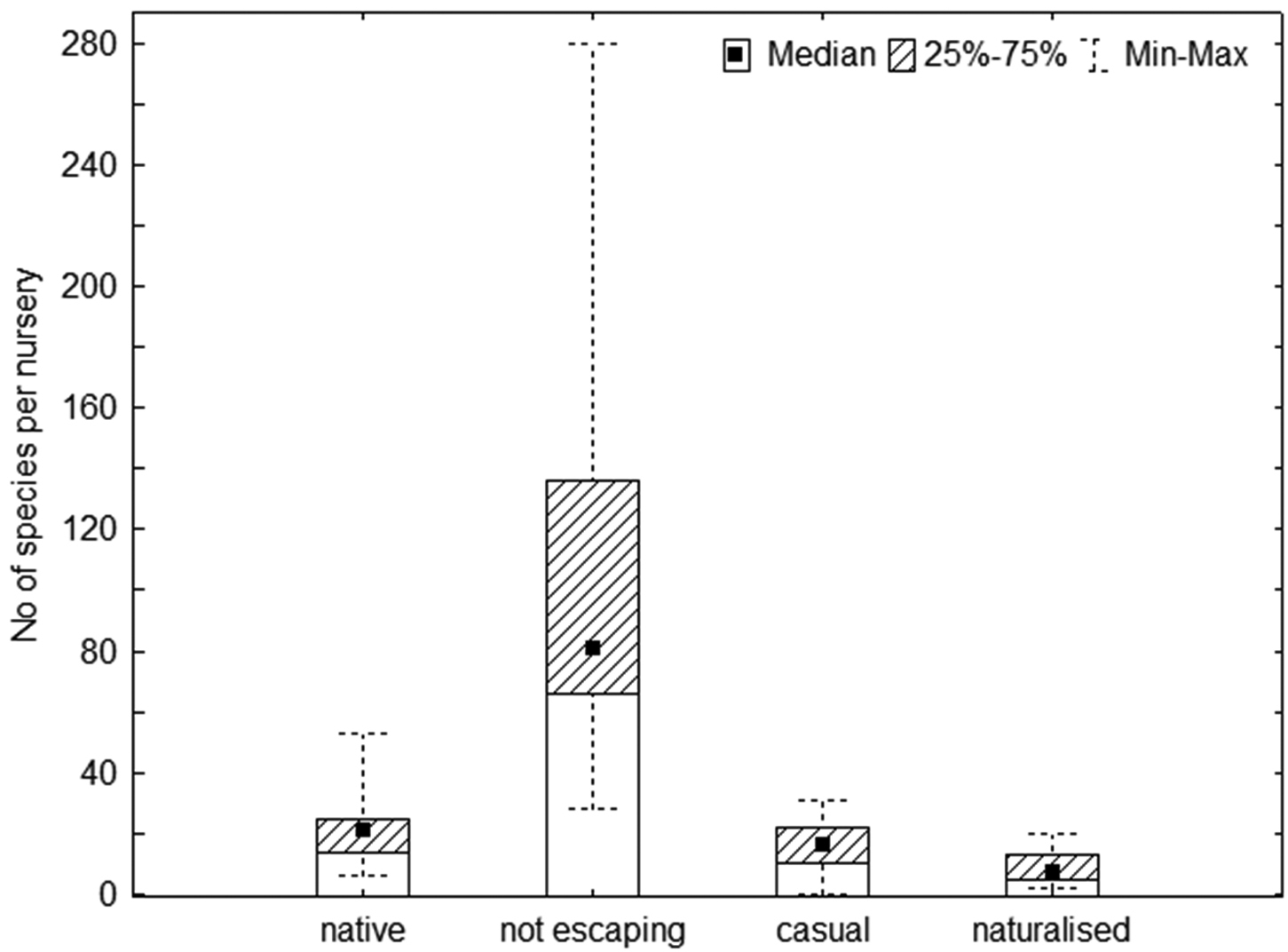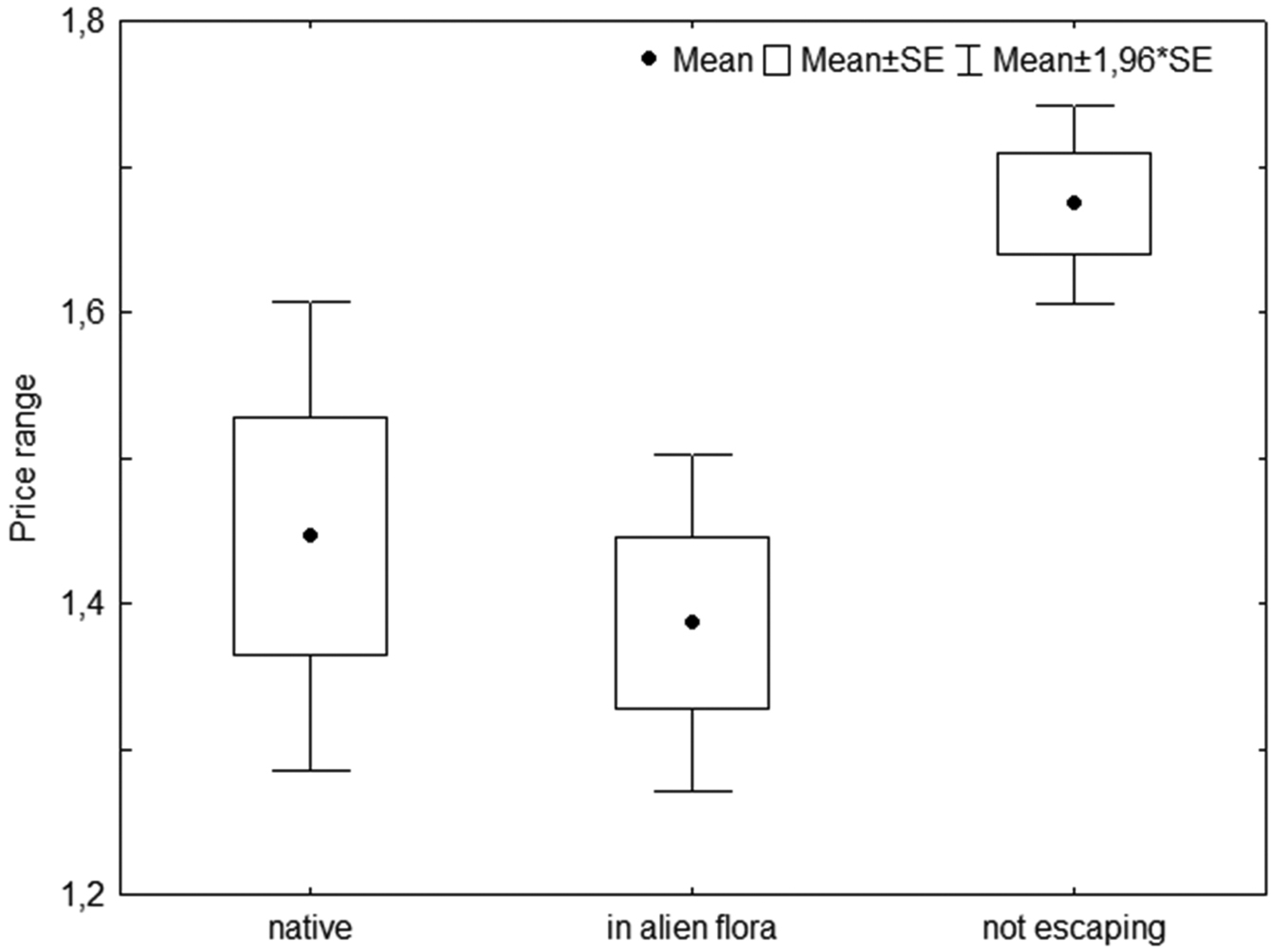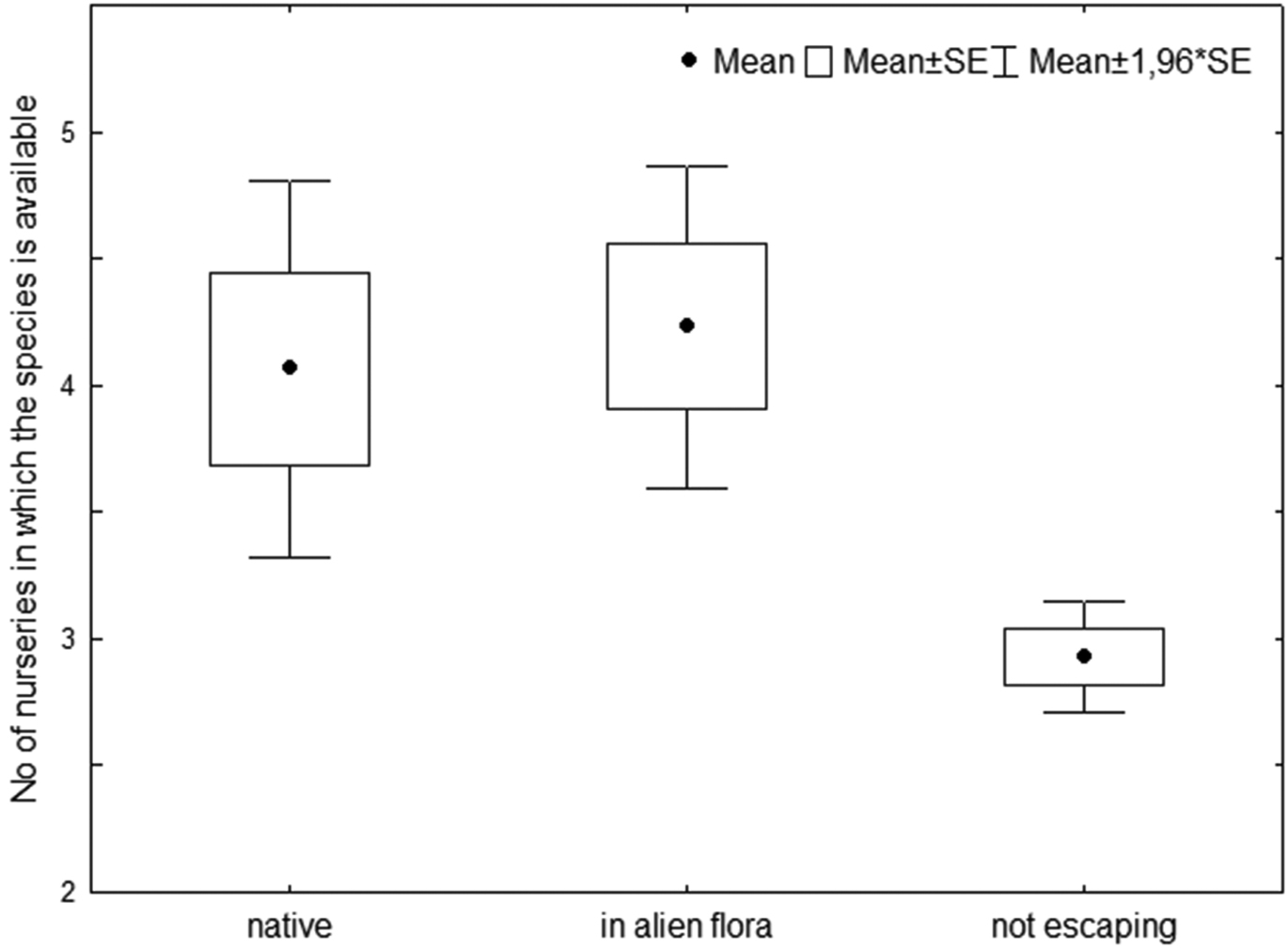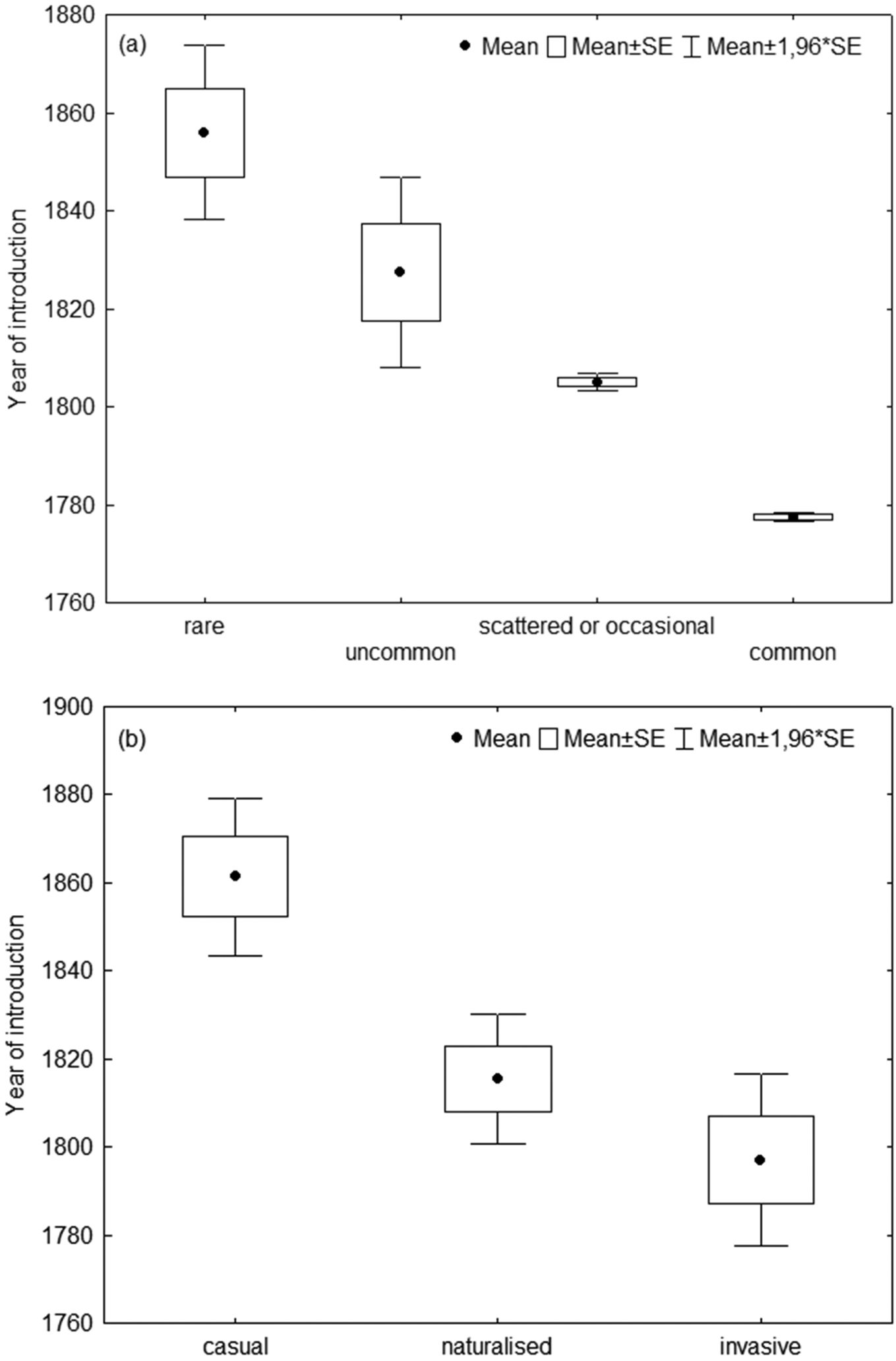






(C) 2013 Merle Ööpik. This is an open access article distributed under the terms of the Creative Commons Attribution License 3.0 (CC-BY), which permits unrestricted use, distribution, and reproduction in any medium, provided the original author and source are credited.
For reference, use of the paginated PDF or printed version of this article is recommended.
Citation: Ööpik M, Bunce RGH, Tischler M (2013) Horticultural markets promote alien species invasions: an Estonian case study of herbaceous perennials. NeoBiota 17: 19–37. doi: 10.3897/neobiota.17.4217
Gardening is a popular pastime, but commercial horticulture is responsible for the introduction of alien species and contributes to invasions in a variety of ways. Although an extensive international literature is available on plant invasions, it is still important at the national level to examine the influence of local factors. Accordingly, 17 nurseries in Estonia that cultivated and sold perennial alien species were selected, and a list of species and prices was compiled. The relationships between species status, and factors such as their abundance in the wild were examined statistically. A qualitative list of the nationally problematic species among herbaceous perennials was also completed. A total of 880 taxa were recorded, of which 10.3% were native and 89.7% alien. In all, 87.3% of the alien species were still confined to cultivated areas. The ecological and socio-economic characteristics of the taxa were described, and lists of the families of casual, naturalised and invasive aliens were provided. Both native and increasing wild alien species have a very similar profile on the market. Alien species that are less expensive, widely available and have more cultivars per species on the market are also more likely to escape. The invasive status and abundance of escaped aliens in an area increases with residence time. In general, socio-economic factors create new and reflect previous propagule pressures from commercial horticulture, which continuously increase the likelihood of alien species surviving and invading new areas. Our findings suggest that these national socio-economic market-related factors explain much of the invasiveness of various perennial ornamental species, and therefore regional and national authorities urgently need to regulate and control the ornamental plant trade to diminish the risk of new invasions.
Perennial alien species, commercial horticulture, human-mediated propagule pressure, residence time, legislation and regulation
Biological and human-mediated mechanisms in invasions of alien plant species are interdependent, and as a result, it is difficult to predict where and why such invasions will occur. However, most plant naturalisations and invaders nowadays originate from and in the future will derive from deliberate importations (
There is now an extensive literature that analyses the reasons why certain species become invasive (e.g.,
Human-mediated propagule pressure from ornamental horticulture itself plays both a direct and implicit role for species to become naturalised and even invasive. At a local level it is particularly important, because it promotes invasions in variety of ways (see, e.g.
It has previously been shown that in the case of the Estonian Alien Flora (
In this paper, the following questions are raised in order to examine the situation in Estonia in further detail:
(i) What is the number of herbaceous perennial species offered for sale, both to horticultural professionals and amateurs? What is the composition of these species?
(ii) Is availability (i.e., lower prices at certain outlets) related to the current status of these species, i.e., the presence of the alien species in the spontaneous flora and/or their abundance in the wild, and how is this connected to species’ residence time in Estonia?
(iii) Does this list include problematic or even legally prohibited alien species that may cause nature conservation problems and therefore needs national attention?
Estonia lies approximately between latitude 58°–60° N and longitude 22°–28° E. According to the
By the end of 2011, the population of Estonia was 1.32 million and had decreased because of migration (
As mentioned above, national wealth is a key parameter in determining the likelihood of plant invasions. In 2011, the Gross Domestic Product per capita of Estonia was 20.2 US Dollars compared with 15.4 for Latvia and 38.3 for Finland. Estonia is, therefore, not in the highest wealth category, but it is still rich compared with countries outside Europe. However, the economy is growing, and gardening is a very popular activity, especially in the countryside where most houses have gardens. There is, therefore, a strong market for horticultural products.
In Estonia, horticulture, vegetable and fruit production have been concentrated in a relatively small number of businesses: approximately 2% of the total number of agricultural companies. There are no exact data on the numbers of nurseries in Estonia specialising in ornamental horticulture. The non-profit Estonian Horticultural Association (www.aiandusliit.ee) brings together companies that produce horticultural products for the market, as well as training and science institutions and companies retailing gardening accessories. There are about 80 members and from their occupational description it is estimated that approximately 25–30 of them are linked to the importation, cultivation on-site, and sale of herbaceous perennial species.
In Estonia, the principal authority on alien species is the Ministry of Environment, which is responsible for legislation and cooperation with international expert groups (e.g.,
The Nature Conservation Act (
The complete list of the texts on invasive species that have been implemented to date; including both those that are legally binding and those that are not; is presented in a report entitled “A Comparative Assessment of Existing Policies on Invasive Species in the EU Member States and in Selected OECD Countries” (
Seventeen nurseries located throughout Estonia were selected for this study. The choice was determined by the availability of catalogues. Firstly, an extensive list of cultivars and prices of herbaceous perennial species was compiled from catalogues, and the data was structured at the species, subspecies, and varietal or hybrid taxonomic level. In addition, basic information was collected for each taxon (Table 1), whenever such information was available. The species status in the Estonian Flora was determined from the Vascular Plant Flora of Estonia (
The content of the database of herbaceous perennial species available in the Estonian horticultural market describing the species characteristics and categories assigned to each individual species.
| Topic | Characteristic | Categories used |
|---|---|---|
| Species identity and taxonomic position | Genus, species, subspecies, family | |
| Species status in Estonian Flora | Native (1) Alien (2) |
|
| Alien species invasiveness on Estonian territory and in the neighbouring countries | Invasive status | Non-escaping (1) Casual (2) Naturalised (3) Invasive (4) |
| Year of introduction | ||
| Year of the first record in the wild | ||
| Abundance in the wild (frequency classes) | Rare (1) Uncommon (2) Scattered or occasional (3) Common (4) |
|
| Invasiveness in |
Potentially invasive or invasive in the region† | |
| Invasiveness in |
0- not mentioned as potentially invasive or invasive; 1- potentially invasive or invasive in one country. Values of 2 or greater denote the number of countries in which the species is potentially invasive or invasive. | |
| Area of origin (floristic element) | America, Asia, Europa, Eurasia (continental), Euro-Siberia, Circumpolar, Africa, Origin unknown (known only from cultivation) | |
| Nursery information (N=17) | Species present on the list of a certain nursery | 0- not present; 1- present |
| Number of nurseries in which the species is available | ||
| Number of cultivars per species available | ||
| Wholesale or retail price in 2010 (divided into ranges) | 1 class up to 30 EEK (approx. 2 EUR) 2 class 31-50 EEK (> 2 to 3.2 EUR) 3 class 51-100 EEK (> 3.2 to 6.4 EUR) 4 class greater than 100 EEK (> 6.4 EUR) |
† Latvia, Lithuania, Finland, Sweden, Denmark, Norway, Poland, European part of Russia
The complete description of species characteristics (Table 1) provides the basis for analysing the relationships between species status (native or alien: non-escaping, casual, naturalised, invasive), abundance in the wild, year of the first introduction (not available for non-escaping aliens), origin area of alien species (
The STATISTICA software system ver. 11 (
As a practical application, a qualitative list of the nationally problematic species among the herbaceous perennials found in horticultural catalogues was compiled, based on data from local sources (
(i) Invasive or naturalised in Estonia and invasive or potentially invasive in at least three neighbouring countries.
(ii) Naturalised in Estonia and invasive or potentially invasive in two neighbouring countries.
(iii) Naturalised in Estonia.
(iv) Casual in Estonia, but invasive or potentially invasive elsewhere. These species are not addressed in this study.
The complete list of perennials in The List of Invasive Alien Species (
The database consists of 3, 697 primary entries. These entries were analysed at the taxonomic level of species (N = 779, 89% of all entries), subspecies (N = 31), and variety or hybrid (N = 70) to produce a list of 880 taxa (hereinafter called species). Of this list, 10.3% (91) are native species, 89.7% (789) alien species. Of all the aliens, 100 have been recorded outside cultivated areas and have reached a certain invasive status in Estonia - 62 are casuals, 35 naturalised, and 3 invasive species: Lupinus polyphyllus Lindl., Saponaria officinalis L. and Solidago canadensis L.. A total of 689 (87.3% of all aliens) are non-escaping species that are still confined to cultivated land. In all, the species belong to 73 families (Table 2) and 269 genera. The native species in the list are most frequently represented by the genus Campanula L.. The most common genera among the alien taxa are Sedum L., Saxifraga L., Aster L., Dianthus L., and Geranium L..
According to their area of origin, 36% of the alien perennial species available on the horticultural market are native to Europe, Eurasia or Euro-Siberia. Approximately 30% are from Asia and 27% from the Americas.
The invasive status of perennial species available in the Estonian horticultural market, listed by family.
| Family | Native species | Non-escaping aliens | Casual aliens | Naturalised aliens | Invasive aliens | All |
|---|---|---|---|---|---|---|
| Asteraceae | 10 | 98 | 16 | 8 | 1 | 133 |
| Ranunculaceae | 7 | 58 | 0 | 3 | 0 | 68 |
| Lamiaceae | 8 | 42 | 12 | 3 | 0 | 65 |
| Caryophyllaceae | 9 | 38 | 6 | 2 | 1 | 56 |
| Rosaceae | 8 | 36 | 3 | 3 | 0 | 50 |
| Saxifragaceae | 2 | 45 | 2 | 0 | 0 | 49 |
| Crassulaceae | 4 | 32 | 5 | 1 | 0 | 42 |
| Primulaceae | 2 | 32 | 0 | 2 | 0 | 36 |
| Scrophulariaceae | 4 | 26 | 3 | 1 | 0 | 34 |
| Brassicaceae | 0 | 22 | 1 | 0 | 0 | 23 |
| Campanulaceae | 5 | 15 | 0 | 0 | 0 | 20 |
| Others | 32 | 245 | 14 | 12 | 1 | 299 |
| Total no of species | 91 | 689 | 62 | 35 | 3 | 880 |
| Total no of families | 32 | 65 | 18 | 18 | 3 | 73 |
The number of species per nursery varied from 41 to 383, and 44% of the species were present in only one nursery. Only one non-escaping alien, Liatris spicata (L.) Willd., was available from all 17 nurseries. Bergenia cordifolia (Haw.) Sternb. and Echinacea purpurea (L.) Moench (both non-escaping aliens) were available from 16 nurseries, and the native Ajuga reptans L. was available from 15 nurseries. The mixture in each nursery was quite similar: 10–20% natives, 60–80% non-escaping aliens, 10% casuals, 2–10% naturalised. Eight nurseries offered invasive species. The largest and most variable category was non-escaping alien species (Figure 1).
The results show that approximately 70% of the species had no cultivars or only one type available for sale. Only 43 (4.9%) of the species had ten or more cultivars per species. The outstanding favourite species was the non-escaping alien Hemerocallis hybrida hort. with 134 different varieties, followed by Sempervivum x hybridum hort. (68), Phlox paniculata L. (65), and the naturalised alien Iris germanica L. (42).
The number of species per nursery (N = 17) according to species status in Estonia. The results are presented in terms of the extreme values of the data and the median. In addition, three invasive species are offered in catalogues of eight different nurseries.
The results show that two groups - native and alien species found outside cultivation of any status from casual to invasive - have a similar market profile, in contrast to non-escaping alien species. Alien species that are able to escape and reach certain invasive status in Estonia, are today less expensive (H = 13.9, DF = 2, N = 668, p = 0.001; Figure 2) and also more widely available (H = 32.6, DF = 2, N = 880, p < 0.0001; Figure 3) than those that have not escaped. In all, the price range of the species is lower when it is widely available and vice versa (R = -0.36, p < 0.05). Also, native and escaping alien species have more developed cultivars per species available on the market (H = 13.26, DF = 2, N = 880, p = 0.001). The latter is also positively correlated to number of nurseries where the species is available (R = 0.66, p < 0.05). In addition, when a species has already reached a certain invasive status in the alien flora, then the price (H = 0.02, DF = 2, N = 86, p = 0.7), availability (H = 0.64, DF = 2, N = 100, p = 0.7) and a number of cultivars per species (H = 2.52, DF = 2, N = 100, p = 0.28) does not differ between groups of casual, naturalised and invasive aliens.
The relationship between species price and status in 17 nurseries in Estonia. Non- escaping aliens were more expensive than natives (z’ = 2.7, p < 0.05) and species in certain status (casual, naturalised, invasive) in alien flora (z’ = 2.8, p = 0.02).
The relationship between species status and availability in 17 nurseries in Estonia. Non-escaping alien species were different from natives (z’ = 4.9, p = 0.007) and aliens in spontaneous flora (z’ = 3.03, p < 0.0001).
Among the already escaped alien species, the abundance (H = 12.3, DF = 3, N = 83, p = 0.007; Figure 4a) and invasive status of species (H = 10.4, DF = 2, N = 86, p = 0.006;Figure 4b) tends to increase with residence time. Invasiveness in the whole region (see Table 1) is also significantly correlated to the year of introduction into Estonia (R = -0.33, p < 0.05), to the species status in Estonia (R = 0.52, p < 0.05) and to the abundance in the wild (R = -0.47, p < 0.05). The supply and demand factors, i.e. today’s availability (R = 0.02, p > 0.05) and price range of alien species in Estonian alien flora (R = 0.08, p> 0.05), is not correlated with introduction time.
The relationship between alien species characteristics and residence time in 17 nurseries in Estonia: (A) species abundance in the wild and residence time (general test was statistically significant (see text), but no significant differences between groups were detected because of small sample sizes), (B) alien species status and residence time. The residence time of casuals were shorter than of naturalised species (z’ = 3.72, p = 0.0006). Sample of invasive species was too small to drive statistically significant conclusions.
As a practical application, a qualitative list of the nationally problematic species among the herbaceous perennials in horticultural catalogues was compiled (Table 3). In Estonia, The Nature Conservation Act forbids the release of alien species into the wild. This Act has resulted in the definition of The List of Invasive Alien Species. For all these species, the import of live specimens and all transactions with live plants are prohibited. As a result, three species are on both the compiled list and the legally defined list.
Estonian commercial nurseries offering herbaceous perennial species, which need national attention as invasive or potentially invasive aliens. Category I: invasive or naturalised species in Estonia and invasive or potentially invasive in at least three neighbouring countries. Category II: naturalised in Estonia and invasive or potentially invasive in two neighbouring countries. Category III: naturalised in Estonia.
| Species in category I | Species in category II | Species in category III |
|---|---|---|
| Lupinus polyphyllus Lindl. | Aster novi-belgii L. | Aquilegia vulgaris L. |
| Solidago canadensis L. |
Euphorbia cyparissias L. | Astrantia major L. |
| Saponaria officinalis L. | Inula helenium L. | Cymbalaria muralis P. Gaertn. et al. |
| Fallopia japonica (Houtt.) Ronse Dec. |
Sedum spurium M.Bieb. | Delphinium elatum L. |
| Fallopia sachalinensis (F.Schmidt) Ronse Decr. |
Aconitum napellus L. | Dipsacus fullonum L. |
| Echinops sphaerocephalus L. | Aruncus dioicus (Walter) Fernald | Doronicum pardalianches L. |
| Telekia speciosa (Schreb.) Baumg. | Bellis perennis L. | Echinops ritro L. |
| Vinca minor L. | Dianthus barbatus L. | Iris germanica L. |
| Fragaria x ananassa Duchesne | Mentha spicata L. | |
| Lychnis chalcedonica L. | Nepeta cataria L. | |
| Malva alcea L. | Ornithogalum umbellatum L. | |
| Rudbekia laciniata L. | Physalis alkekengi L. | |
| Salvia verticillata L. | Primula elatior (L.) Hill | |
| Viola odorata L. | Primula vulgaris Huds. | |
| Sanguisorba minor Scop. | ||
| Sisyrinchium angustifolium Mill. |
† Species are on The List of Invasive Alien Species (Regulation of the Estonian Minister of Environment No 34, 14 May 2007) - importing live specimens and all transactions with live specimens are prohibited, as stated in The Nature Conservation Act.
It is generally accepted that only a limited fraction of introduced species in a given area become naturalised and an even smaller number eventually cause problems (
Invasions have a highly dynamic nature, and many of the most problematic alien species are not recent arrivals, but they reflect historical human activities, a phenomenon termed an invasion debt (
Recently, it has been shown that residence time is a pivotal factor in the spatial patterns of alien species and human pressure has a greater influence on species that have been introduced more recently (
Propagule pressure created by the historic factors of supply and demand is also an important part of the explanation for the invasiveness of ornamental species (
The objective of breeding plants to encourage specific traits differs between agriculture and ornamental horticulture. Obviously, bred ornamental cultivars are genetically distinct from the wild genotype of the species, but usually the change in genetic composition is minor and has little to do with the traits that lead species to become naturalised and invasive (
The financial costs to countries of controlling the major invasive species are very high and pose serious problems (
The one pro-active possibility is that green lists should be compiled. These lists would be especially useful in large-scale projects and would not contradict any trade agreements (
Why should the horticultural industry care about alien species? This question arises because the problems caused by alien species do not have a substantial impact on the industry. For this reason, it is probable that further regulation will be difficult. An economical study by
1) The availability of plants from the horticultural trade is a major source of alien species, including locally and regionally naturalised and invasive plants.
2) Supply and demand factors create new and reflect previous propagule pressure and are an important component of the reasons behind the invasiveness of ornamental species. In general, native and expanding wild alien species have a very similar profile on the market - both are inexpensive and widely available, and more cultivars per species are also available.
3) There are urgent requirements for regional and national authorities to regulate and control the ornamental plant trade in order to diminish the risk of new invasions.
4) It would be helpful to involve the public in finding alternatives and encouraging best practices for both horticultural professionals and amateurs.
The authors are grateful to the many nursery professionals contacted during this study for their help with the acquisition of the data and to Freda Bunce, Marguerite Oetjen and Simon Bell for improving the English of the paper. Ingolf Kühn provided useful comments on a draft of the manuscript, and feedback from two anonymous reviewers significantly improved this work.



